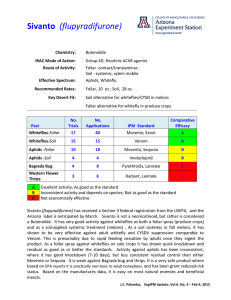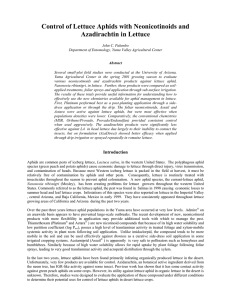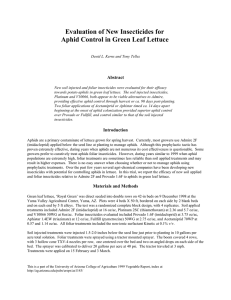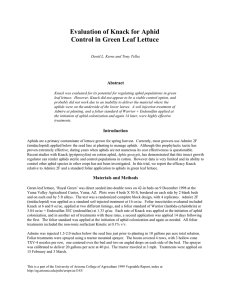Neonicotinoids and Azadirachtin in Lettuce: Comparison of
advertisement
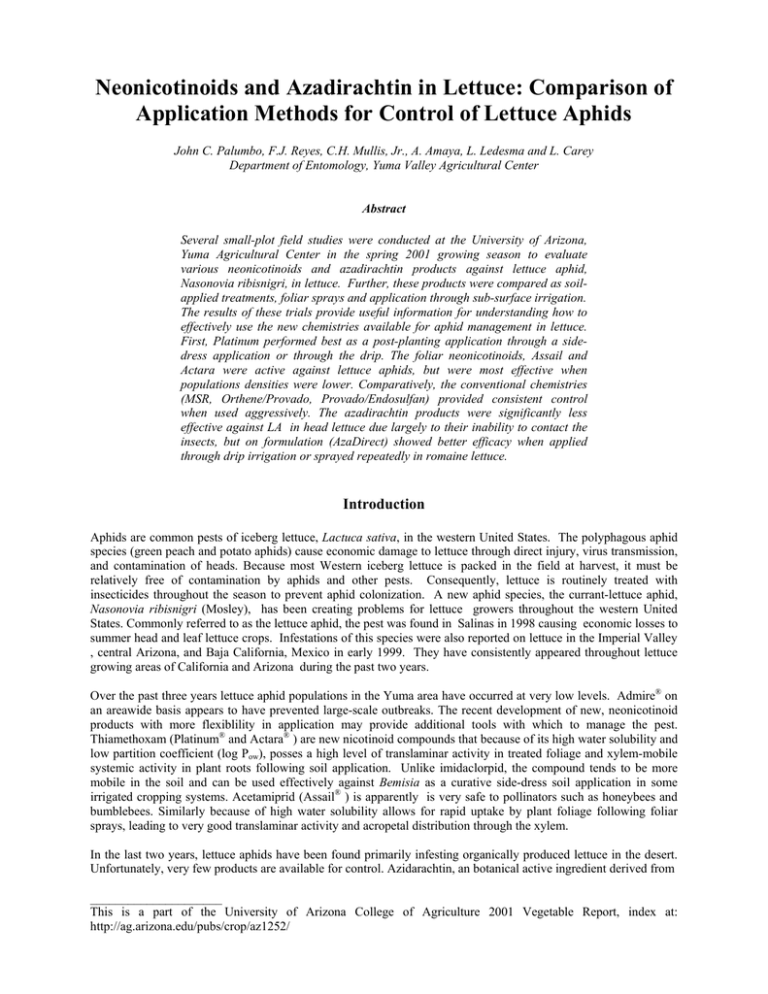
Neonicotinoids and Azadirachtin in Lettuce: Comparison of Application Methods for Control of Lettuce Aphids John C. Palumbo, F.J. Reyes, C.H. Mullis, Jr., A. Amaya, L. Ledesma and L. Carey Department of Entomology, Yuma Valley Agricultural Center Abstract Several small-plot field studies were conducted at the University of Arizona, Yuma Agricultural Center in the spring 2001 growing season to evaluate various neonicotinoids and azadirachtin products against lettuce aphid, Nasonovia ribisnigri, in lettuce. Further, these products were compared as soilapplied treatments, foliar sprays and application through sub-surface irrigation. The results of these trials provide useful information for understanding how to effectively use the new chemistries available for aphid management in lettuce. First, Platinum performed best as a post-planting application through a sidedress application or through the drip. The foliar neonicotinoids, Assail and Actara were active against lettuce aphids, but were most effective when populations densities were lower. Comparatively, the conventional chemistries (MSR, Orthene/Provado, Provado/Endosulfan) provided consistent control when used aggressively. The azadirachtin products were significantly less effective against LA in head lettuce due largely to their inability to contact the insects, but on formulation (AzaDirect) showed better efficacy when applied through drip irrigation or sprayed repeatedly in romaine lettuce. Introduction Aphids are common pests of iceberg lettuce, Lactuca sativa, in the western United States. The polyphagous aphid species (green peach and potato aphids) cause economic damage to lettuce through direct injury, virus transmission, and contamination of heads. Because most Western iceberg lettuce is packed in the field at harvest, it must be relatively free of contamination by aphids and other pests. Consequently, lettuce is routinely treated with insecticides throughout the season to prevent aphid colonization. A new aphid species, the currant-lettuce aphid, Nasonovia ribisnigri (Mosley), has been creating problems for lettuce growers throughout the western United States. Commonly referred to as the lettuce aphid, the pest was found in Salinas in 1998 causing economic losses to summer head and leaf lettuce crops. Infestations of this species were also reported on lettuce in the Imperial Valley , central Arizona, and Baja California, Mexico in early 1999. They have consistently appeared throughout lettuce growing areas of California and Arizona during the past two years. Over the past three years lettuce aphid populations in the Yuma area have occurred at very low levels. Admire® on an areawide basis appears to have prevented large-scale outbreaks. The recent development of new, neonicotinoid products with more flexiblility in application may provide additional tools with which to manage the pest. Thiamethoxam (Platinum® and Actara® ) are new nicotinoid compounds that because of its high water solubility and low partition coefficient (log Pow), posses a high level of translaminar activity in treated foliage and xylem-mobile systemic activity in plant roots following soil application. Unlike imidaclorpid, the compound tends to be more mobile in the soil and can be used effectively against Bemisia as a curative side-dress soil application in some irrigated cropping systems. Acetamiprid (Assail® ) is apparently is very safe to pollinators such as honeybees and bumblebees. Similarly because of high water solubility allows for rapid uptake by plant foliage following foliar sprays, leading to very good translaminar activity and acropetal distribution through the xylem. In the last two years, lettuce aphids have been found primarily infesting organically produced lettuce in the desert. Unfortunately, very few products are available for control. Azidarachtin, an botanical active ingredient derived from _____________________ This is a part of the University of Arizona College of Agriculture 2001 Vegetable Report, index at: http://ag.arizona.edu/pubs/crop/az1252/ the neem tree, has IGR-like activity against some insect. Previous work has shown that it has some contact activity against green peach aphids on some crops. However, its utility against lettuce aphid in organic lettuce in the desert is unknown. Therefore, studies were designed to evaluate the application of these compound under different conditions to determine their potential uses for control of lettuce aphids in desert lettuce crops. Methods and Materials Several small-plot field studies were conducted at the University of Arizona Yuma Agricultural Center in the spring 2001 growing seasons. In each trial, lettuce was direct seeded into double row beds on 42 inch centers and sprinkled beginning the following day. Plots for each trial consisted of 4 beds, 60' long with a two bed buffer between the plots, except for the drip irrigation trial where plots were 50' long. Plots were arranged in a randomized complete block design with four replications. All foliar spray applications were made with a tractor-mounted hydraulic boom sprayer operated at 50 psi and 26.5 gpa. A directed spray (~75% band, with rate adjusted for band) was delivered through 3 nozzles (TX-8) per bed. The at-planting soil applications of imidacloprid (Admire) and thiamethoxam (Platinum) in the furrow irrigated head lettuce trials were applied as a preplant injection at a depth of 1.5" below the seed line at bed shaping in 10 gpa final dilution. The side dress treatments were applied similar to fertilizer side dressing and the materials were placed in the same location as N in 10 gpa final dilution. Chemigation and other treatments applied in each trial are provided in the descriptions below. Comparison of Soil-applied Applications of Neonioctinoids in Head Lettuce Lettuce ‘Del Rio’ was direct seeded on Nov 17, 2000. Soil treatments were applied at planting,as a sidedress operation, (Feb 1, 2000) and as three foliar sprays (Jan 25, Feb 9, & Feb 21, 2000) to coincide with initial green peach aphid colonization. The following treatments were evaluated: 1) Admire 2F at 16 oz oz /acre at planting; 2) Platinum 2SC at 9 oz / acre at planting ; 3) Platinum 2SC split application with 5 oz applied at planting and 5 oz side dressed On Feb 1; 4) Platinum 2SC side dressed at 9 oz / acre on Feb 1; 5) Neonicotinoid foliar spray regime consisted of Actara 25W at 3 oz/acre on Jan 25, Assail 70WP at 1.2 oz/acre on Feb 9, and Provado at 3.75 in combination with Warrior at 3.8 oz/acre on Feb 21; 6) Conventional foliar spray regime consisted of Dimethoate at 12 oz + Orthene 97 at 1.0 lb /acre on Jan 25, MSR at 1.5 pts/acre + Capture at 4.0 oz/acre on Feb 9, and Provado at 3.75 in combination with Endosulfan at 32 oz/acre on Feb 21; and 7) a untreated control Comparison of Foliar Applications of Neonioctinoids and Azadirachtin in Head Lettuce Lettuce ‘Del Rio’ was direct seeded on Nov 15, 2000. Two soil treatments were applied at planting as standards, and foliar sprays of the neonioctinoids and azadirachtin were applied on Jan 25, Feb 9, & Feb 21, 2000 to coincide with initial green peach aphid colonization. The following treatments were evaluated: 1) Admire 2F at 16 oz oz /acre at planting; 2) Platinum 2SC at 9 oz / acre at planting ; 3) Assail 70WP at 1.2 oz/acre on Jan 25 and Feb 9; 4) Actara 25W at 3 oz/acre on Jan 25and Feb 9; 5) Conventional foliar spray regime consisted of Dimethoate at 12 oz + Orthene 97 at 1.0 lb /acre on Jan 25, MSR at 1.5 pts/acre + Capture at 4.o oz/acre on Feb 9; 6) Agroneem at 48 oz/acre was applied on Jan 18, 25, 31, Feb 9, 14 and 21 in combination with a crop oil concentrate (Comate 101 , 1% v/v) and buffered to pH of 6 using Tomahawk (Galic extract buffer); and 7) an untreated control. Late-season Foliar Lettuce Aphid Trial.. Lettuce ‘Beacon’ was direct seeded on Jan 15, 2001. Foliar applications were initiated when aphid colonization was first detected . Sprays were applied on Mar 20 and 27, 2001. The following treatments were applied: 1) Standard soil treatment - Admire 2F at 16 oz oz /acre at planting; 2) Actara 25W at 3 oz/acre ; 3) Pirimor at 6 oz/acre ; 4) Aza-Direct at 24 oz/acre ; 5) a conventional rotation of standard control treatments: Orthene 97 at 1 lb, plus Provado at 3.75 oz/acre on Mar 21; MSR at 2 pts/acre on Mar 28 ; and 7) an untreated control. Comparison of Drip Irrigation of Neonioctinoids and Azadirachtin in Romaine Romaine ‘PICII’ was direct seeded on Jan 18, 2001. Split applications of Admire, Platinum and Aza-Direct were applied via a venturi injection system to sub-surface irrigated plots. Treatments were applied as follows : Admire at 12 oz and Platinum at 7 oz were injected first on Feb 22 following stand establishment. A second injection was made on March 28. Three injections of AzaDirect at 24 oz/acre were made on Feb22, Mar 14, and March 28. Foliar applications of AzaDirect at 24 and 32 oz/acre, Agroneem at 48 oz/acre and Pirimor at 3-6 oz/acre were made on Feb 22, Mar 20,1,10 and 20, 2001. Aphid populations were assessed by estimating the number of aphids /plant in whole plant, destructive samples. On each sampling date, 8-10 plants were randomly selected from each plot and placed individually into large 3-gal tubs. Each plant was sampled by visually examining all plant foliage and counting the number of alate and apterous aphids present. At harvest, infestation levels of apterous aphids were estimated by randomly selecting 10 plants within each replicate, visually counting the number of aphids on frame/wrapper leaves and heads. Data was analyzed using ANOVA and mean differences were estimated using a protected LSD(0.05) or a paired t test(p< 0.05). Results and Discussion Comparison of Soil-applied Applications of Neonioctinoids in Head Lettuce Both green peach (GPA) and lettuce aphids (LA) were present in this study (Figure 1). Foliar sprays and the side dress applications of Platinum coincided with the initial presence of LA on plants. About mid-way through the crop season , GPA peaked at about 50 aphids / plant, but quickly crashed following two significant storms (0.9 “ and 1.45” rain on Feb 25 and Mar 6, respectively). Prior to that time, all insecticide treatments appeared to provide relatively good control. Ironically, it was about the same timing that LA population began to rapidly increase. LA population peaked on 6 Mar. LA were significantly higher in the at-planting neonicotinoid treatments than any of the other soil or foliar treatments. However, at harvest (16 Mar), LA numbers declined in these treatments. In the check, large numbers of lady beetles and syrphid flies were present, feeding on the abundance of aphids found in the heads. Neither the Admire or Platinum at-planting treatments differed from the untreated check. Lettuce heads samples from plots treated with the foliar spray regimes and the Platinum side dress (9 oz) maintained LA to very low levels for the duration of the test and were the only treatments that resulted in marketable heads at harvest. Comparison of Foliar Applications of Neonioctinoids and Azadirachtin in Head Lettuce Similar to the soil trial, both green peach (GPA) and lettuce aphids (LA) were present in this study (Figure 2). Again perhaps coinciding with weather events, GPA population peaked around 25 Feb, but quickly crashed just prior to harvest. At that time all treatments had significantly fewer GPA than the check, with Actara and Assail maintaining aphids to a very low level. At harvest (12 Mar), GPA numbers in plant heads did not differ among treatments and were all less than 2/head. However, significant differences in LA infestation and head contamination were detected among treatments at harvest. LA were slow in appearing in this trial, but increased rapidly once detected. Surprising, the intensive use of Agroneem resulted in significantly higher LA numbers than the untreated control. Similar to the previous soil-applied trial, LA populations in the Admire and Platinum plots were not significantly reduced compared with the check. However, the two applications of Actara and Assail provided significantly better control than the untreated check, but the number of LA in the Assail plots averaged nearly 10 / head. Overall, the conventional chemistries provided the most consistent control with only 2 applications. Comparable control may have been achieved with the neonicotinoids had a third application been made 14 days before harvest. Late-season Foliar Lettuce Aphid Trial Only LA were present in this study. Because the study was conducted later in the season when temperatures averaged about 67-70ºF, infestations were much higher. The purpose of this study was to determine the residual activity of some of the compounds. AzaDirect under these conditions provided no control of LA. Similarly, Admire at-plating provided marginal control near harvest, but still resulted in significantly infested heads. Pirimor provided fair control up to about 7-10 days following the second application. Although significantly lower than the check, LA were able to readily infest lettuce heads at high numbers in the Pirimor plots at harvest. Clearly, both the Actara and the Orthene+Provado followed by MSR, treatments provided the best residual control. Control was exceptional for 14 d following application. Both treatments provided about 95% control at harvest compared with the check, but still resulted in about 20 aphids/head at harvest. Under some market conditions these heads would be acceptable. Comparison of Drip Irrigation of Neonioctinoids and Azadirachtin in Romaine This study was originally designed to evaluate the effects of azadirachtin against GPA. We had been given some indication that it might possibly have some systemic activity if applied through drip irrigation. However GPA populations never built up. Against LA, the AZADirect formulation did have some systemic activity. Three drip applications at 24 oz provided comparable control to 5 succesive foliar application, both being significantly lower than the untreated check. A higher rate of the foliar AzaDirect actually provided even significantly better control. The results of this study also showed that azadirachtin efficacy is influenced by formulation. Although AZADirect at 32 oz provided significant control, the Agroneem formulation did not differ from the check on any sample dates. These products are made by different manufacturers and the quality of the azadirachtin and oil-based carriers is obviously different. The fact that AZADirect provided efficacy through the drip is surprising, but certainly merits some further investigation. Both the split applications of Admire and Platinum almost completely prevented the establishment of LA, and was particularly effective following the 2nd application. The results of these trials provide useful information for understanding how to effectively use the new chemistries available for aphid management in lettuce. Obviously , the insecticidal activity of these new, selective chemistries against lettuce aphid can be greatly influenced by application method, frequency, and timing. First, Platinum performed best as a post-planting application through a side-dress application or through the drip. The foliar neonicotinoids, Assail and Actara were active against lettuce aphids, but were most effective when populations densities were lower. Comparatively, the conventional chemistries (MSR, Orthene/Provado, Provado/Endosulfan) provided consistent control when used aggressively. This is not surprising as these compounds are the industry standard in other areas. The azadirachtin products were significantly less effective against LA in head lettuce. However, the AZADirect formulation appeared to have some contact activity in romaine where sprays can more easily reach lettuce aphids early in the season. In other baby spinach trial not reported here, we observed AZADirect efficacy against GPA where it is easier for the product to contact aphids. The application of azadirachtin through the drip system also suggests the possibility of some significant systemic effects against aphids and should be investigated further. #1 60 Mean aphids / plant 50 40 30 #2 #3 Green Peach Aphid A Admire -at plant Platinum -at plant Platinum - split application Platinum -side dress Neonico Foliar Conventional Foliar Untreated * Side dress applied 20 10 0 13 Jan 30 Jan 8 Feb 21 Feb #2 #3 #1 100 6 Mar 16 Mar Lettuce Aphid B Mean aphids / plant 80 60 40 * Side dress applied 20 0 13 Jan 30 Jan 8 Feb 21 Feb 6 Mar 16 Mar Figure 1. Comparison of Admire and Platinum soil application for control of green peach aphid (A) and Lettuce Aphid (B) in Head Lettuce. Green Peach Aphid 50 * * #1 * #2 * * A Admire -at plant Platinum -at plant Assail - foliar Actara -foliar Agroneem -foliar Conventional Foliar Untreated 40 Mean aphids / plant * 30 20 10 0 17 Jan 1 Feb 8 Feb 16 Feb 25 Feb 12 Mar Lettuce Aphid 50 * * #1 * * #2 * * B Mean aphids / plant 40 30 20 10 0 17 Jan 1 Feb 8 Feb 16 Feb 25 Feb 12 Mar Figure 2. Comparison of Foliar Neonicotinoids and Azidirachtin for Control of of Green Peach Aphids (A) and LettuceAphids (B) in Head Lettuce 350 325 300 275 125 #2 Lettuce Aphid Admire - 20 oz Actara - 3 oz Pirimor - 6 oz AzaDirect - 24 oz 1) Orthene / Provado 2) MSR Untreated 100 Harvest Lettuce aphids / plant #1 75 50 25 0 March 21 March 28 April 3 April 10 April 17 Figure 3. Comparison between of Neonicotinoid and Azidiractin Residual Activity Against Lettuce Aphid in Late-season Head Lettuce Foliar Spray #1 Foliar Spray #2 Foliar Spray #4 Foliar Spray #3 Foliar Spray #5 350 Mean Lettuce Aphids /Plant 300 Drip # 2 Drip # 1 Drip # 1 Drip # 1 Drip # 3 Drip # 1 Admire -Drip - 12 oz (1) ; 8 oz (3) Platinum - Drip - 7 oz (1) ; 4 oz (3) AZA-Direct (Drip) 24 oz (1,2,3) AZA-Direct (foliar) 24 oz AZA-Direct (foliar) 32 oz Agroneem (foliar) 48 oz Pirimor (foliar) 3-6 oz Untreated 250 200 150 100 50 0 Feb 20 March 8 March 22 April 2 April 16 Figure 4. Comparisons ofDrip and Foliar Applications of Azidirachtin and Split Drip Application of Admire and Platinum for Lettuce Aphid Control in Romaine Letttuce


